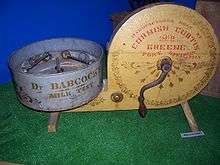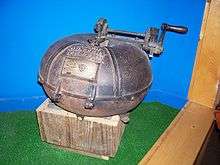Babcock test


The Babcock test is the first inexpensive and practical test factories could use to determine the fat content of milk.
Motivation
Until the 1890s, dishonest farmers could water down their milk or remove some cream before selling it to the factories because milk was paid for by volume. Honest farmers, as well as those that produced naturally rich milk, were not being compensated fairly.
Babcock Test process
Stephen Moulton Babcock researched the problem at the University of Wisconsin–Madison and developed the following process:
- Measure milk into graduated test tube. You usually take 18 grams of milk or 17.6 milliliters.
- Add 17.6 milliliters of 90-92% sulfuric acid.
- Centrifuge at 50°C.
- Measure fat which will be floating on top of liquid in the test tube.
Principle of Babcock test
Key to this process is that everything in milk except the fat dissolves in sulfuric acid. The fat floats to the top. The centrifuge ensures complete separation with no bubbles in the fat, and the fat content can be measured using the graduations on the test tube and knowing the initial amount of milk used.
Utility of Babcock test
After the development of the test, it was much easier for a dairy operation to not only compensate farmers fairly, but to produce a consistent product that consumers could depend on. The Babcock test was also utilized by farmers to selectively breed for cows who produced milk with higher butterfat content—the tests were usually done monthly by an employee of the local Dairy Herd Improvement Association (DHIA).
In 1911, the American Dairy Science Association's Committee on Official Methods of Testing Milk and Cream for Butterfat, chaired by O. F. Hunziker, met in Washington DC with the U.S. Bureau of Dairying, the U.S. Bureau of Standards and manufacturers of glassware. Standard specifications for Babcock glassware were published as a result of this meeting.[1]
About Babcock
Babcock's refusal to patent his process or the device led to its widespread diffusion.[2][3]
See also
| Wikimedia Commons has media related to Babcock test. |
- Stephen Moulton Babcock
- Hydrometer - Device for measuring milk's relative density
- Fat content of milk
- Niklaus Gerber
- Gerber Method
References
- ↑ Herreid, Ernest O. "The Babcock Test; A Review of the Literature" (PDF). Journal of Dairy Science. American Dairy Science Association. 25 (4): 342–343. doi:10.3168/jds.s0022-0302(42)95301-3. Retrieved 2008-06-19.
- ↑ Ionel Rosenthal and Baruch Rosen. "100 Years of Measuring the Fat Content of Milk". Journal of Chemical Education, 70(6)481-482.
- ↑ Babcock's Revolutionary Dairy Invention. Wisconsin Historical Society.